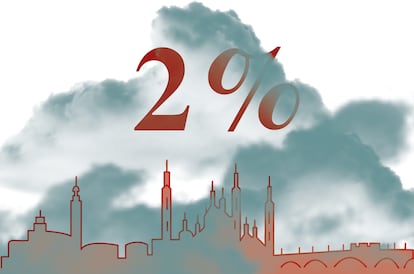From the ‘Great Moderation’ to the ‘Great Volatility’
If there are no new shocks, inflation will slow down and central banks will be able to better calibrate their policies

Since the early 1990s, when the period of the “Great Moderation” began and the combination of technological progress, deregulation and globalization generated a virtuous cycle of growth with low inflation, central banks were living in the sweet spot. With inflation stabilized around the 2% target, or even below, all they had to do was manage the business cycle, raising rates very gradually when the economy grew above potential. Although the objective was price stability, the reality is that central banks were dedicated to stabilizing growth and unemployment, since inflation depended on fluctuations in demand.
Monetary policy during those decades was straightforward and did not require difficult or controversial decisions. Debates focused on minor issues, such as assessing if the effort to avoid weak inflation was excessive – for example, the potential side effects of zero interest rates or asset purchases. Granted, it was a difficult period in which central banks had to manage the financial crisis and avoid a repeat of the Great Depression, but central banks were the heroes that prevented catastrophes. The debate was about how much to ease financial conditions.
All that changed last year.
The powerful shock waves of the Covid-induced shutdown and subsequent rapid reopening has compressed into two years an economic cycle that would typically last eight to 10 years, replacing the “Great Moderation” with the “Great Volatility.” Now the debate centers on how much to tighten financial conditions – that is, how much to raise interest rates to reduce economic growth and increase unemployment – in order to reduce inflation. To ease one pain – the rise in prices – central banks have to generate another pain – the economic slowdown. And, even more stressful for central banks, they must decide how much to tighten financial conditions while not really understanding why inflation has risen so much or how long it will last. It’s like driving in the dense fog.
Because a sudden increase in inflation may seem like a failure for a central bank, even if it is not. The decades of the “Great Moderation” entrenched the image that central banks had a strong control over inflation, when the reality is that it was a mix of good policies and good luck: during the “Great Moderation,” the structural trends were disinflationary and the shocks relatively minor. All central banks had to do was to be disciplined and not make big mistakes.
In the “Great Volatility,” the trend has been reversed. Structural trends – the re-regionalization of supply chains, the wide use of sanctions, tariffs, energy policy as geopolitical weapons, the fight against climate change – are inflationary, and the shocks have become bigger and more frequent. In the US, up to two thirds of the price increases are due to exogenous supply shocks, against which the central bank can do little. In the eurozone, it is likely that almost all the price increases are due to shocks of this nature.
Why, then, are central banks raising rates at high speed? On the one hand, because unemployment has fallen rapidly to historical lows and interest rates must therefore be adjusted to slightly restrictive levels. On the other hand, because in the face of exogenous shocks it is necessary to anchor inflation expectations and thus avoid the so-called “second round effects” – a process by which workers see price increases and request wage increases, companies pass these wage increases to their prices, and then workers ask for new wage increases, etc…
For now, these second-round effects have not occurred, as nominal wages have risen well below inflation. In fact, the evidence suggests that the price increases have been largely due to rising business margins. After a decade in which companies competed for market share, scared of global competition, they have taken advantage of widespread volatility to increase margins and prices. Nevertheless, to ensure that there are no second round effects, and to prevent further margin increases, central banks want to slow down the economy by raising rates to a sufficiently restrictive level.
Nor are the dynamics of inflation expectations clear. After decades emphasizing its importance as an anchor for monetary policy, the reality is that we do not really know what they are or how they are formed. Medium to long-term inflation expectations (five to 10 years), after a brief period of volatility following the Russian invasion of Ukraine, have remained firmly anchored around the target – the proverbial Martian who landed on Earth and saw a graph of such expectations would not be able to guess that inflation has since skyrocketed to double digits. But, what has caused this anchoring? The credibility of central banks, which have raised rates rapidly? Or do expectations simply mirror the volatile evolution of energy prices, rising and falling in unison?
The same is true of short-term inflation expectations (one to three years). These have risen rapidly, but the evidence indicates that they mostly reflect the current rise in inflation, stemming mainly from food and energy prices, rather than a conviction that inflation will continue to rise at this rate beyond the next year. Nor is it clear that small businesses weigh inflation expectations when deciding how much to raise prices.
But if there are no second-round effects and expectations have not been unanchored, why so much emphasis on raising rates quickly and saying that a recession will not be enough to contain inflation? Because central bankers are buying inflation insurance. Perhaps when the fog lifts, it will prove that the insurance was excessive. But this new regime of “Great Volatility” requires greater precautions, in both directions.
The key is not to overshoot the caution. The acceleration of rate hikes since the summer has likely added unnecessary volatility to the economic outlook. Many academics, and central bankers, after many years bemoaning the emphasis on low inflation, are now exaggerating their anti-inflation worries. Which is a mistake: inflation that is too low is just as bad as inflation that is too high. Both detract from future growth. In fact, this episode of high prices should be used opportunistically to finally stabilize inflation at a higher level than before Covid, at a level more in line with the 2 percent target.
If there are no new shocks, inflation will slow in the coming quarters, the fog will lift, and central bankers will be able to better calibrate monetary policy. In the “Great Volatility,” shocks determine the behavior of the economy and inflation, and no scenario should be ruled out. Central banks must be well-prepared to react, in a symmetric fashion.
Tu suscripción se está usando en otro dispositivo
¿Quieres añadir otro usuario a tu suscripción?
Si continúas leyendo en este dispositivo, no se podrá leer en el otro.
FlechaTu suscripción se está usando en otro dispositivo y solo puedes acceder a EL PAÍS desde un dispositivo a la vez.
Si quieres compartir tu cuenta, cambia tu suscripción a la modalidad Premium, así podrás añadir otro usuario. Cada uno accederá con su propia cuenta de email, lo que os permitirá personalizar vuestra experiencia en EL PAÍS.
¿Tienes una suscripción de empresa? Accede aquí para contratar más cuentas.
En el caso de no saber quién está usando tu cuenta, te recomendamos cambiar tu contraseña aquí.
Si decides continuar compartiendo tu cuenta, este mensaje se mostrará en tu dispositivo y en el de la otra persona que está usando tu cuenta de forma indefinida, afectando a tu experiencia de lectura. Puedes consultar aquí los términos y condiciones de la suscripción digital.
More information
Últimas noticias
Trump claims peace in Ukraine is near, but Moscow suggests otherwise
A survivor’s account of the Interoceanic Train accident: ‘We were scared because of the speed on the curve’
The Interoceanic Train, the Mexican alternative to the Panama Canal
What is known about the Interoceanic Train derailment in Oaxaca
Most viewed
- Oona Chaplin: ‘I told James Cameron that I was living in a treehouse and starting a permaculture project with a friend’
- Reinhard Genzel, Nobel laureate in physics: ‘One-minute videos will never give you the truth’
- Why the price of coffee has skyrocketed: from Brazilian plantations to specialty coffee houses
- Pablo Escobar’s hippos: A serious environmental problem, 40 years on
- Chevy Chase, the beloved comedian who was a monster off camera: ‘Not everyone hated him, just the people who’ve worked with him’











































